Friendship Bridge over the Amu Darya: as it were. From the history of 16 separate pontoon - bridge regiment
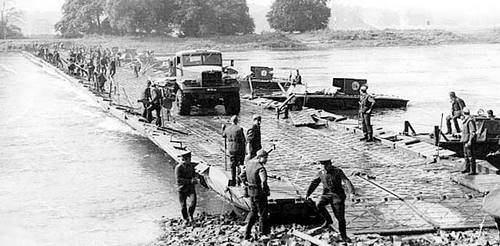
Thirty-six years ago, December 27 1979, the Soviet troops entered Afghanistan. On the eve of the next anniversary of this event, I would like to recall how this input became possible. It will be a question of 16-m separate pontoon - bridge shelf, which provided the crossing of troops in the Termez region.
His history The 16 th regiment has been conducting since August 1945. After the end of the Great Patriotic War, the reduction and redeployment of troops, the 89 and 122 th Guards Verkhne-Dnieper pontoon-bridge battalions arrive in Kiev from Poland. Here they are connected to a separate spare heavy pontoon-bridge regiment with 10. On the basis of this regiment, to ensure the advancement of strategic reserves from the depth of the country during the threatened period and the duplication of existing bridges and crossings in case of emergency situations during peacetime, 20 August 1945 the 16 th separate motorized pontoon-bridge Ukhne-Dnieper regiment was formed (military unit 75110) with a location in Kiev. The headquarters of the regiment was located on Moskovskaya Street, 22 (now the commandant's office of the Kiev garrison is located there). Colonel General Grechko, the commander of the KVO troops, ordered the regiment to form the former commander of the 89 pontoon - bridge battalion, Major K. Kharitonov.
The first two regimental commanders — Major K. Kharitonov and Colonel I. N. Polozhenko — headed the part of the entire 4 month for two. In fact, the first commander of the regiment, who contributed his work to his organization, the formation and consolidation of the team was Hero of the Soviet Union, Lieutenant Colonel Andzaurov Igor Evgenievich. He commanded the regiment of the year - from April 1946 to April 1947. In April, the regiment receives the Hero of the Soviet Union Colonel Berzin Yan Andreevich. It was he who was the front-line hero who commanded the regiment for 1947 years, managed to raise the combat readiness of the unit to the proper level, and also to master the new equipment and weapons.
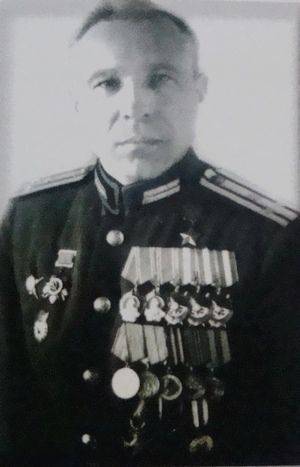
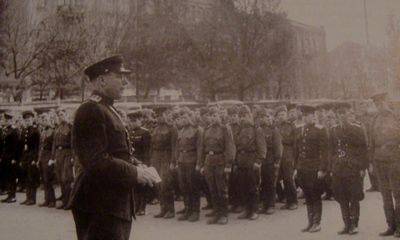
One of the glorious and heroic pages in the history of the regiment was the Afghan war, or rather its very beginning. It was this regiment that suggested crossing over the r. Amu Darya, according to which Soviet troops entered Afgan and on the site of which the "Friendship Bridge" was soon built.
And now everything is in order.
Anxiety. The road to Afghanistan.
11 December 1979 city. Night. Suddenly a wild howl of a siren destroyed the idyll of winter silence. ANXIETY! Soon the officers of the regiment gathered in the class of tactical - special training. The commander of the unit, Lieutenant Colonel A. Tretina, read the directive of the General Staff of the Armed Forces of the USSR. She ordered: a regiment consisting of two pontoon - bridge battalions, companies of tracked self-propelled ferries (10 GSP ferries), a platoon of floating conveyors (9 PTS), 32 tugboats and three sets of marine equipment for PTS to march along the railway, unload on Termez station of the Uzbek SSR and enroll at the disposal of the Chief of the Engineering Troops (NIV) of TurkVO for participation in military exercises.
It took only a few hours to assemble the soldiers, sergeants and officers from other parts and prepare the first echelon. An order was also given: pontooners called up in the fall remain in the unit.
The commander of the unit, the p / p Tretina, understood that the regiment passed the most important exam during its existence. The situation in the part was tense, even nervous. The whole parade ground was scored by the Volga of the district headquarters. Representatives of each service tried to help, but often this help only hindered. Every soldier, every officer, as taught by A. Suvorov, knew his maneuver.
With long-term storage, the equipment was removed, people arrived from the engineering parts. The regiment had a staff of about 400 people, and brought it to 860. This task 16 th pontoon - bridge regiment has not yet performed. A huge amount of work was piled up on the zampotekh of the regiment of Ivan Savchenko and his subordinates — from removing machines from long-term storage to providing each BAT, KrAZ vehicle, and boat on platforms with fixing material. During the day, only in the paratrooper battalion, 30 units of tracked vehicles, PTS and GSP, were removed from storage and prepared for the march and loaded onto platforms.
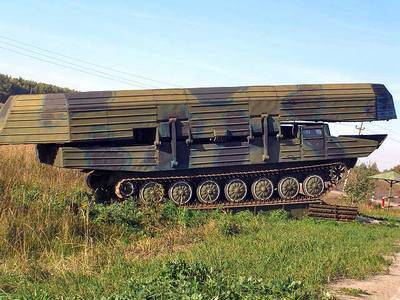
The regiment commander made the decision to march in five echelons from the loading stations of Brovary, Darnitsa and Petrovka and appointed the commanders of the echelons: №1 - deputy regiment commander major Krivosheenko G. V, №2 - deputy. chief of staff of the regiment major Sergeev V.S., №3 - headed personally by the regiment commander, №4 - deputy. regiment commander on the technical part of Lieutenant Colonel I. L. Savchenko, №5 - Chief of Staff of the Regiment Lieutenant Colonel P. P. Wallo
The first early morning of December 11 from the Petrovka station were the units of the 1 pontoon-bridge battalion. Within a day, all 5 trains were loaded. To drive huge KrAZ trucks onto the platforms with links, PTSy and GSP were entrusted only to experienced drivers. But for them the maneuvers on concrete and metal that were slippery from ice were extremely difficult. It also affected the lack of experience and skills of the personnel to make marches by rail.
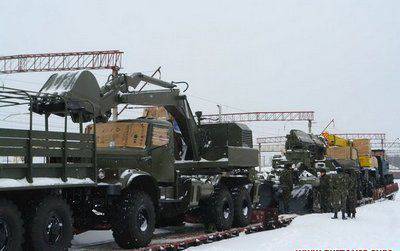
The first echelon departed on 14.00 11 December 1979 in 21.00 and 2 3 December 7.00 and 12 in 4 5. During the march, all trains were given the "green light". Everything was done under the guise of military exercises, but everyone understood that in the area of the city of Termez there was only one big river, the Amu Darya, and the Soviet-Afghan border ran along the fairway.
Overcoming more than 5000 km, December 18, all the regimental trains arrived at their destination. The difficult process of unloading hundreds of vehicles passed without incident. Specially made calculations under the guidance of officers and ensigns quickly and competently carried out the unloading of equipment. Especially clearly acted calculations under the command of Lieutenant Colonel Tikhomirov, captain Polyakov, Art. Lieutenant Chumakov.
The first echelon, like all subsequent ones, was personally met by the head of the engineering troops (NIV) of the district, Major General Alexander Sergeevich, who urgently arrived from Moscow by plane. Along with him came several officers of the engineering department of the CER. Before his appointment to Kiev, General Korolev held the position of NIV TurkVO, so his experience and knowledge of the regiment's theater of action was most welcome. Korolev immediately said that there was a civil war in Afghanistan, and the pontoon was immediately aware that they, at least, would have to build a bridge or bridges over the Amu Darya. The regiment concentrated a few kilometers east of Termez, north of the Amu Darya, where for several hours it equipped a concentration area with a field camp, a fleet of vehicles, and organized guard and internal services.

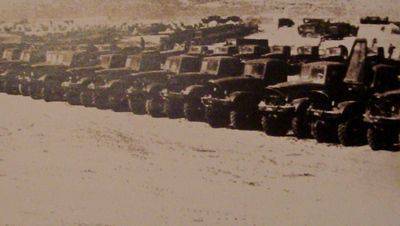
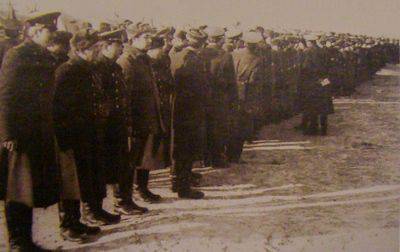
While the units were engaged in the arrangement, a reconnaissance group composed of the regimental commander, s / n Tretina A., deputy. Krivosheenko G. composer, officers of Tikhomirov O. units, Fedorov U., Yurchenko V., led by Major General Korolevy A., departed to the river. Everyone was invited to the border guard boat and, without disturbing the usual schedule of his movement, went along the Soviet coast. The task of the pontooners is to study the coast of a contiguous state, to determine a possible place for building a bridge.
Intelligence - diving platoon under the command of Art. Ensign Nevzglyad L. I. conducted a qualitative reconnaissance of the river. After intelligence, everyone was, if not dejected, then pretty worried. The width of the river was about 700 m, the opposite bank is steep, steep, up to 8-12 m height, the bed of the Amu Darya is restless, the bottom is sandy, changing. But the most unpleasant is the flow velocity of about 3 m / s. This is the limit of tactical - operational capabilities of the pontoon - bridge park (PMP). It was difficult to determine the location of the bridge. After listening to the commanders of the units and taking into account the intelligence data, the regimental commander decided to equip a ferry near the axis of the reinforced concrete bridge under construction across the Amu Darya, which had so far been said to have started a robot on the Soviet coast. A few years later, a bridge will be built here, along which the 40 Army will emerge from Afghanistan.
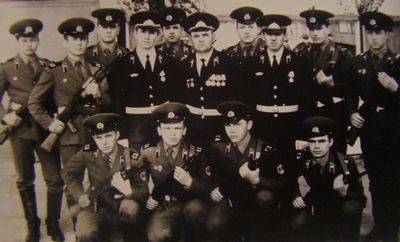
In this axis there was an alluvial island, which allowed reducing the length of the floating bridge to 150 m, unloading the material part of the park directly from the island, and most importantly, it would be easier to hold the tape of the bridge in such a course. But for this it was necessary to strengthen the island. They turned to local authorities for help. The road to the bridge across the island was laid with reinforced concrete slabs, a layer of clay was poured on top and rolled. From the end, the island was reinforced with fascicles to hold the sand, and a special barrier was established for vehicles during unloading.
The unloading of links and boats was supposed to be carried out on the planned axis of the bridge with their subsequent fastening to the bridge ribbon as they are assembled. In addition, it was planned to use river tugs. flotilla and PTS — to feed the tape into the axis on the opposite bank with a cable length of 300 m. As it turned out, subsequently this decision of the regiment was the only correct one. The Murom POMB was given assistance to the 16th pontoon regiment, which was to direct a bridge crossing to an island 150 meters long, since there was not enough of its own, regimental, materiel.
And so, the place for the bridge was established. The real battles flared up around the method of its guidance. The big bosses from Moscow suggested to unload the material part of the bridge three kilometers upstream and ferry it to the target by ferries. Regiment command opposed. It was not possible to reach a common decision. Then the commander A. Tretina called Art. Ensign L. Nevzglyad. As the pontoners joked, for all the “great things” the first was a platoon of engineering intelligence Art. ensign. The commander set the task to scout thoroughly all the shallows from the place offered by the Muscovites to the alignment of the bridge.
Leonid Nevzglyad recalled: “I took several six-meter-long armaturins with me on the TCP, attached flags to them and stuck it on the shoals. And suddenly he noticed that a branch of a tree floating near me for some reason had lagged behind. Unleashed the TCP back and see that the branch was stuck in the mountain of sand, which was formed quite recently, and as the iceberg was barely hidden under water. If you let the ferries down the river, they will be stuck in the aground like a steamer in the film “Volga-Volga”, from which the actors tumbled into the water. But we are not artists. Before us is the state task "
As soon as Nevzglyad reported on his observations, everyone agreed that the crossing should be directed immediately to the axis of the bridge. Before giving the order for the equipment and maintenance of the crossing, Tertina's p / p reported its decision to the NIV of the TurkVO p to the Zhernov. Upon learning that, because of the steepness of the shore, the links could not be unloaded on a broad front, he became thoughtful. It turned out that the crossing should be directed “by calling”, for which purpose to use the calculations of only one company, which was responsible for the entire regiment. Kompolka reported that it would be the 1-I pontoon company of Captain Yurchenko. It is clear that the captain and his subordinates had no experience of working on such a fast river as the Amu Darya. But in the company, as in the whole regiment, in the course of constant training and exercises, real professionalism was acquired and accumulated, and there was also a great desire to fulfill the order.
Taming the river.
On the night of 24 on 25 of December 1979, the regimental commander received an order: in 7.00 25.12.79, the frontier control line would be opened to intercept the Amu Darya bridge. Time to bridge the bridge - 12 hours. The 4.00 regiment was alarmed. The regiment commander ordered the issuance of ammunition, grenades, and by the head of the regiment's column head 7.00 to cross the state border for the equipment of the bridge crossing.
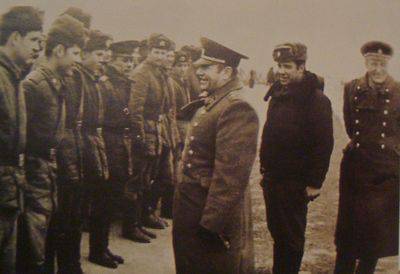
At exactly the set time, the regiment led by a platoon of the PTS crossed the border and went to the Amu Darya, which had not been conquered by anyone since A. Macedonian. Pontoners knew that a few months ago during the exercises of the Charjou pontoon - the bridge regiment failed to cope with the crossing of the obstinate Amu Darya. And this further raised the sense of responsibility of everyone - from the private to the regiment commander.
And work began to boil. Unloading the links was led by the battalion chief of staff, Major Y. Fedorov, company commander V. Yurchenko, and the boat was launched by the commander of the 4 th company, captain E. Ibrahimov. Three river tugboats from the port came to the rescue. The river was unloaded and squeezed into tight embraces, tore out of the hands of pontooners, circling, making it impossible to join the links to the tape of the bridge.
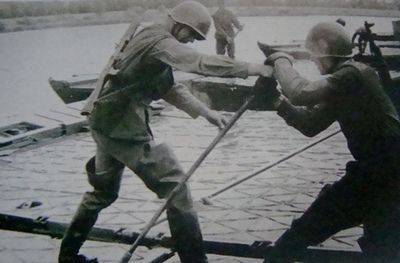
As soon as the first links were joined, an 300-meter cable with PTS-M was attached to the coastal link, and captain V. Osipov together with the calculation and mechanical drive of the conveyor ml. Sergeant I. Ayrikh, unwinding the cable, moved to the opposite shore. And there they were met ... soldiers of the Afghan army. Situated half a kilometer from the coast and at intervals of 100 m, they behaved friendly and without signs of hostility observed the action of the pontoon. Osipov on the radio reported to the regimental commander and said that the cable was stretched and the calculation was ready for pushing the tape.
For the preparation of the "Afghan" coast, the equipment for leaving the bridge on a barge in the port area sent a team with a BAT-M overpass builder headed by deputy regiment commander Major G. Krivosheenko. In a short time, the team prepared a section of the opposite shore for interfacing with the coastal link. At the same time, the calculation of one of the TCP headed by art. Ensign I. Khromenko. The car was tightened under the tape of the bridge, but the “grandfather”, as lovingly called Ivan Vasilyevich, was co-workers, at the cost of incredible efforts, “pulled out” the TCP, which saved not only the car, but also the calculation.
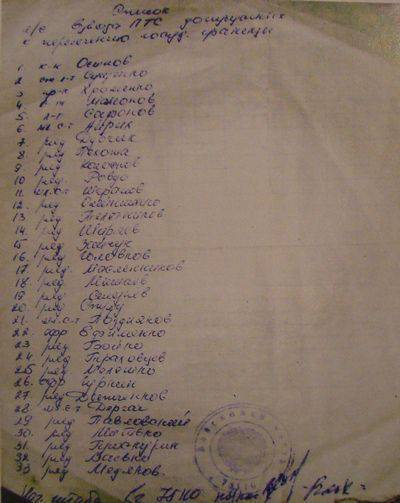
When joining the bridge tape with the opposite bank, another problem arose - two links were “superfluous”. The river showed its cunning, not by the day, but by the hour changing the depth and direction. I had to urgently take action. About the withdrawal of links could be no question. There was only one thing to do - pull the ribbon of the bridge to the shore. Calculations of the PTS of the airborne assault battalion successfully coped with this difficult task.
Through 2,5 hours the bridge tape (long 314,75 m) was assembled. It was necessary to equip a reliable entry and exit from the bridge and, most importantly, fasten the tape of the bridge with the banks. Initially, this task was performed using BAT-M, BTS-4А and PTS-M cables. As a test load on the bridge forwarded BTS. After that, the regiment commander A. Tretina and the commander-in-chief S. Sinekop marched across the bridge, checking his readiness for work. Further, the p / p Tretin reported to Colonel-General S. Akhromeev, the deputy chief of the General Staff, who was watching the actions of the pontoon boats, about his readiness to forward troops. Soon the first units of the 40 Army went across the bridge.
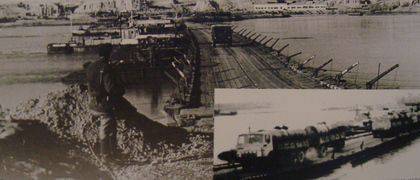
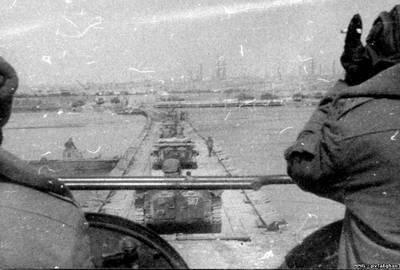
[u] [Historical reference. / u]
The first, wooden, bridge was built under the direction of General of the Russian Tsarist Army M. Annenkov in May, 1888, when Russia was just beginning to develop Central Asia. Then the Transcaspian railway was built, and the crossing of the Amu Darya was necessary. The Amu-Darya railway bridge was strengthened on wooden stilts, and its length was almost three kilometers. He was named the largest engineering achievement of the time. Alas, the bridge has served all 14 years: because of the rapid flow of the river and the sandy bottom, the bridge began to collapse and quickly became unusable.
At the beginning of the XX century. The Trans-Caspian railway was renamed the Central Asian, because now it covered the whole of Turkestan. And the load on the Amudarya bridge has become so significant that it required urgent modernization.
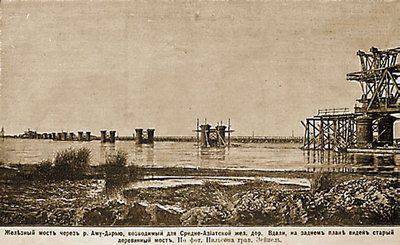
Construction of the new, now iron, ferry began in 1902. The construction was supervised by an outstanding engineer S. Olshevsky, who already had experience in building large bridge structures on the West Siberian, Aral and other railways. He constructed on the recalcitrant Amu Darya a sturdy 27 railway bridge span, which became one of the largest in the world at that time. The bridge was worked perfectly. Maybe that's why the next “upgrade” of the facility took place only after 77 years, already in Soviet times.
The current railway-road bridge, 816 meters in length, was built in 1985 by Soviet builders at the height of the Afghan war. That year, the partial withdrawal of Soviet troops from Afghanistan began, and the new bridge was symbolically called the Friendship Bridge as a sign of hope for an early end to the war and the establishment of friendly relations between states. In 1989, it was for him that the withdrawal of Soviet troops from Afghanistan was solemnly completed.
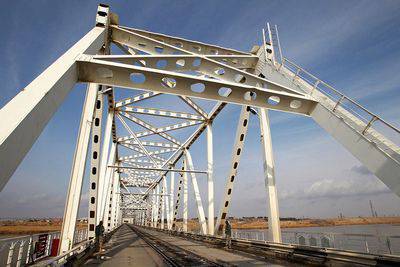
After the end of the war in Afghanistan, at the end of 90's. In the 20th century, the Taliban captured the northern provinces of Afghanistan, and the Friendship Bridge was renamed Hairaton. For security reasons, the bridge was closed. Movement on it was resumed only in 2001 year. The ceremonial opening of the bridge marked the sending of 16 wagons with humanitarian aid, and the bridge was renamed again the Bridge of Friendship. Currently, the bridge is operational, and freight and road transport is carried out.
From 25 December, the 1979 regiment proceeded to the maintenance of the crossing. They deployed the commandant’s service, together with the border guards organized the upper and lower outposts, an evacuation group, and strengthened the guard of the bridge. The first commandant of the crossing, p. P. Tikhomirov and his assistant, captain Tropov, organized the accounting of the transported equipment, the connection between the banks and the concentration camp. Commander of a platoon of communication Lieutenant V. Kravtsov, head of the R-140 radio station, Ensign M. Prishchep provided the regiment commander with a steady relationship with the TurkVO headquarters, with the 40 Army, between the regimental units and the ferry.
Within a few days, the regiment transported troops to the army — more than 2000 tracked and 40000 units of wheeled vehicles.
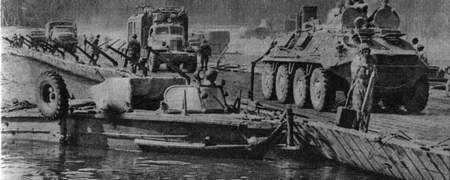
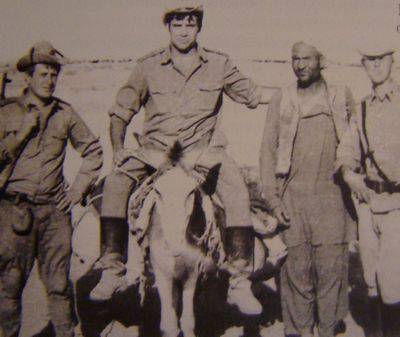
Before the regiment got a new task - how to keep the crossing? The flow of the Amu Darya was so strong that the regular anchors slid along the sand like boots on ice. The special anchors - suckers delivered from the Leningrad Research Institute did not help either. Their principle of operation is based on vacuum action. While all this was tried, the bridge was kept by boats and PTS led by the company commander captain V. Osipov. But the exit was found by experts from the captain Fedoruk. A Zvig company technician made a screw anchor. The screwing of these “anchors” into the soil was carried out by the cable-block system of the unloading KrAZ. Tugs, boats, PTS, and then anchor-anchors not only securely held the bridge, but also allowed to plant it, passing vessels carrying cargo along the Amu Darya. It was impossible to allow large losses in connection with building a bridge and stopping shipping. Therefore, it was necessary to 1-2 times a week to make the bridge wiring at a flow rate exceeding the permissible norms. To accomplish this task, two bridge teams were created headed by the commanders 1 POMB, 2 POMB, PESB. The first trial layout was attended by the Deputy Minister of Defense, Army General Sokolov. He praised the actions of the pontoners.
18 February 1980 was sent to the place of permanent deployment of the first echelon, which was headed by Captain V. Osipov, with the equipment and personnel of the GSP company. February 22 Echelon safely arrived in Kiev.
Fighting weekdays.
After bridge laying, a strict order was received: to let everyone in and not let anyone out. In Afghanistan, the technique was streaming, back - in any case. They were afraid of provocations.
A few hours later, the officers were informed: Amin was overthrown in Kabul, and Babrak Karmal came to power. It became clear to everyone that the resistance will increase and it is necessary to strengthen the guard of the bridge, the location of the units, increase vigilance. At the same time, the pontoon team was given a new task: in 40 km from the location of the regiment, the 1 battalion needed to build a road. After the march, the 1 Battalion determined the location, quickly dug the pipes in - supports and pulled the thorn. They also installed several searchlights, borrowed from motorized riflemen, erected two towers with machine-guns, and installed signal-signals around the camp. The entire work was directly supervised by the Chief of Staff Major Fedorov.
During the construction of the road, the pontoners were also able to surprise the top commanders. When the heat in 50 - 55 degrees, they had to build on 1km of canvas in the day. But there were not enough gravel transport vehicles. Then on KrAZ craftsmen - repairmen from the platoon of Art. Lieutenant Raikhman was fitted with wooden platforms, two old automobile ramps were laid on them, tied with a cable, the end of which hung from the side of the car. The gravel was poured onto the site, they were brought to the roadway, a special tractor was dragging the ramps by the cable, and they poured the gravel. So much for the dump truck.
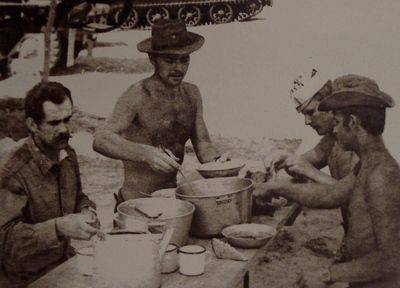
At the beginning of 1980, a new task was set before the regiment: in the area of the settlement Ayvadzh Kurgan - Tyube region. Tajik SSR to build a highway bridge across the Amu Darya and a road to the highway. This crossing was of strategic importance. It shortened the way for our troops, which went deep into Afghanistan, by 300 km. But what forces to build it? The solution was found simple: on the basis of an engineering platoon to form a separate company as part of 120 people. The commander of the company was appointed Major Istomin Nikolai Sergeevich - the chief of physical training and sports, the deputy commander - Lieutenant Guschvius, the commanders of platoons - Lieutenants Pogorelov and Orphan, the deputy commander of the company for the technical part - Ensign Kozhemyakin.
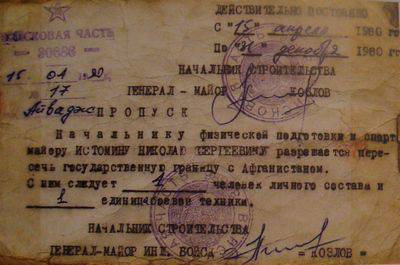
In the twenties of March 1980, the company made a march on 40 km, in the Ayvaja area, crossed over to the Afghan coast and set up a camp there. The personnel engaged in the preparation of the site for the assembly of the BARM bridge (Large road collapsible bridge). A week later, the entire regiment arrived and began building the road and the piers for the bridge. Part of the personnel on the regular pontoons of the park PMP built floating ships and hammered into the bottom metal pipes from which the bulls of the future bridge were formed.
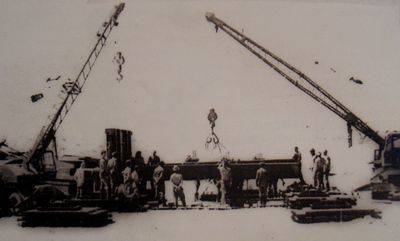
The company Istomina delivered the components of the crossing from the station to the site where the bridge was assembled. Not only did the sizzling heat, the white sun of the desert put pressure on the psyche, and everyone felt like they were on a heated frying pan, more and more often they were harassed by dushmans. The bridge under construction obviously did not give anyone peace, and only the machine guns of the two platoons of the motorized infantry units, the guard of the bridge, blocked their path. One morning, the commander of one of the platoons reported that armed people had appeared from the reeds, saw military escort and disappeared.
Nikolai Istomin recalls: “In order not to be hooked by the dushmans, we took an armored troop-carrier and decided to impose our tactics on them. Between the village and the reeds they took a position, set up an ambush. And suddenly from the side of the village they opened fire on us. I ordered the same answer. In short dashes, firing on the move, under the cover of an armored troop-carrier, we attacked the duvali. One of the attackers was injured and four were killed. As soon as I walked away a little, a sub-machine-gun banged behind my back in a dozen paces, and the bullets passed next to my right foot. I dashed to the side, turning back and throwing up the machine gun. A motorized infantry soldier Kishev stood on a hillock with a semi-lowered rifle and pointed the trunk at a bush of thorny thickets. Dushman with a rifle fell out of it. Only an hour later, moving away from the excitement of the battle, I realized how close I was to the edge of my life. ”
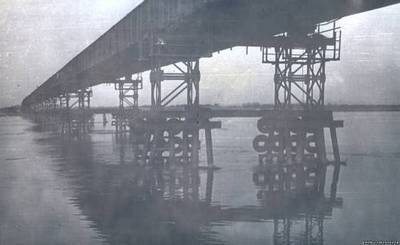
After 70 days the construction of the bridge was completed. For the fulfillment of the task, the initiative shown during the construction of the bridge, company commander Nikolai Istomin was awarded a diploma by the head of the engineering troops, and the personnel in the person of the crane operator Private Saturday Alexei and senior engineer, diver Okadas Hubert, received the Medal for Military Merit.
The last task.
When part of the regiment was already in winter quarters and it seemed that the overall task was nearing its end, 1 August 1980 the regiment received the directive NIV TurkVO on the construction by the regiment of a gravel road from Sardoba to Tashkurgan with the length of 27 km. Urgently formed a company as part of 60-ti people. The battalion chief of staff, captain Vladimir Toropov, recalls: “The equipment was built in a column, the property was loaded, the remains of firewood for PCBs and prepared for the march to the Sardoba district. Of course, the soul rushed to Kiev, to the family, but we are military people and our duty is to carry out orders. Our column has not yet reached its destination, as everything sank in a sandstorm. Flew "Afghan". It became impossible to move, sand clogged eyes, fell everywhere, into the smallest gaps, there was a danger to the operation of engines. The column had to stop. So, on the first day we didn’t get to the future camp, we had to sleep in cars. The next day, we had to work doubly - to set up a camp, to conduct a reconnaissance of the terrain and roadway, a quarry, to prepare equipment. ”
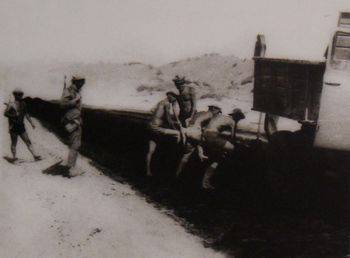
Rothe had a chance to work under difficult conditions: the shoulder of gravel was 20 km, dump trucks were fairly worn when building the BARM bridge, the equipment could not withstand the heat, the wheels sometimes burst right in motion, and accidents occurred. I had to organize a vulcanization post directly in the area of work. The first 13 km of the road was built in a month. The second section, gaining experience, is already much faster.
The combined company of Captain Toropov, having built the road to Tashkurgan, arrived in Kiev on an organized and without incident on September 23 1980. This was the last unit of the regiment that had returned from the Afghan trip. The task of state importance set for the regiment was accomplished with honor.
Back in March, 1980, by order of the USSR Defense Minister D. Ustinov, the regiment for high field training and combat skills, courage and bravery shown by personnel in equipping and providing the crossing was awarded Vympel of the USSR Ministry of Defense "For courage and military prowess." In addition, the deputy regiment commander for political affairs S. Sinekop and technical I. Savchenko were awarded orders of the Red Star, the commander of 1 Company V. Yurchenko received the Order For Service to the Homeland in the USSR Armed Forces, and the reconnaissance commander L. Nevzglyad received a medal "For distinction in military service," and Private A. Saturday - with the medal "For Military Merit."
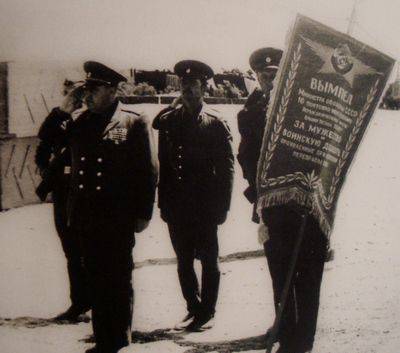
But the highest award was the one that the pontooners were in full force and returned home without loss.
Sources:
Bridges connecting the hearts: Memories of veterans of the 16-th separate POMP.- K., 2010.
http://www.advantour.com/rus/uzbekistan/termez/friendship-bridge.htm
http://www.russianarms.ru/forum/index.php/topic,3101.msg8837.html
http://www.russkiymir.ru Русское чудо в черных песках
Information